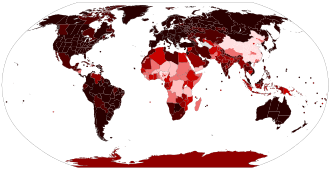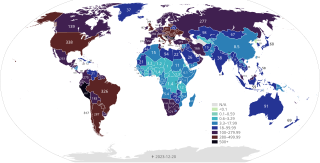
Back Covid-19-pandemie Afrikaans COVID-19-Pandemie ALS 2019-20 ኮሮናቫይረስ ወረርሽኝ Amharic Lifong no kemi AMI Pandemia de COVID-19 AN COFID-19 myċelcoþu ANG جائحة فيروس كورونا Arabic وباء كوڤيد-19 ARZ ক'ভিড-১৯ বৈশ্বিক মহামাৰী Assamese Pandemia de COVID-19 AST
| COVID‑19 pandemic | |||||||
|---|---|---|---|---|---|---|---|
 Confirmed cases per 100,000 population
as of 20 November 2022
| |||||||
| |||||||
| |||||||
Clockwise, starting from top:
| |||||||
| Disease | Coronavirus disease 2019 (COVID‑19) | ||||||
| Virus strain | Severe acute respiratory syndrome coronavirus 2 (SARS‑CoV‑2)[a] | ||||||
| Source | Probably bats, possibly via pangolins[2][3] | ||||||
| Location | Worldwide | ||||||
| First outbreak | Wuhan, Hubei, China[4] | ||||||
| Index case | Xiaogan, Hubei, China 30°37′11″N 114°15′28″E / 30.61972°N 114.25778°E | ||||||
| Date | 17 November 2019–5 May 2023[4][5] | ||||||
| Confirmed cases | 775,335,902[6] | ||||||
Deaths | 7,045,569[6] | ||||||
The COVID-19 pandemic, also called the coronavirus pandemic, was a world-wide pandemic of coronavirus disease 2019 (COVID-19). It is caused by severe acute respiratory syndrome coronavirus 2 (SARS-CoV-2).[1][7][b]
The disease was first found in Wuhan, Hubei, China, in December 2019. On 31 December, Chinese health authorities told the World Health Organization (WHO) about a group of viral pneumonia cases of unknown cause,[8][9] and an investigation was launched in early January 2020.[10] The virus is believed to have come from an animal source, possibly a bat, and it is thought to have been transmitted to humans at a live meat market in Wuhan where live animals were being sold. The virus quickly spread to other parts of the world by airplanes and ships, because of its highly infectious nature and ease of transmission. The World Health Organization (WHO) called it a pandemic (global disease) on 11 March 2020.[11]The International Committee on Taxonomy of Viruses gave the virus its name. As of 30 April 2024, about 775,000,000 cases of COVID-19 have been reported, and about 7,040,000 people have died of COVID-19.[6]
The virus mostly spreads when people are close to each other, which is why social distancing is used.[12] Common symptoms include fever, cough, and trouble breathing.[13] The illness can worsen with pneumonia and acute respiratory distress syndrome.[14] As of January 2021, a number of vaccines for COVID-19 have been developed, but only a few have been found safe to use. The first vaccine to be approved was created by Pfizer and BioNTech,[15] followed by the Oxford / AstraZeneca [16] vaccine. Vaccine distribution was started in many countries in Europe, North America, South America and Asia.[17] The United Kingdom was the first western country to begin to give out a COVID-19 vaccine. [18] The vaccine was given out to all people in the country for free. No antiviral medicine for COVID-19 is available.[19] Doctors usually give patients supportive therapy instead such as giving fluids, food, oxygen, pain relief and other treatments designed to help patients deal with the symptoms.[20] People can avoid spreading the virus by regularly washing their hands, covering their mouth when coughing, maintaining distance from other people, staying away from crowds, wearing medical or cloth face coverings, and being alone for people who think they are infected, also known as quarantining.[19]
The outbreak might be from a coronavirus that usually lives in bats. This then likely infected another animal, possibly a pangolin. It then changed inside that other animal until it could infect humans.[21] It possibly originated at a wet market (a live food animal market), Huanan Seafood Wholesale Market.[22] A 55-year-old person from Hubei province was the first human to contract the virus on November 17, 2019.[23] A 61-year-old man who was a regular customer at the market was the first person to die from the virus on January 11, 2020.[24] The exact origin of the virus is still unknown since the market in Wuhan sold a variety of live wild animals in cages. Chinese tourists have spread the virus by traveling to other countries and made it a worldwide pandemic.[25]
Racism and xenophobia against Chinese people and Asians increased during the pandemic.
In November 2020, two companies, Pfizer and Moderna, said they had finished making COVID-19 vaccines. Two mRNA vaccines, one by Pfizer and one by Moderna, have been tested. Both were over 90% effective.[26] Countries began planning to give the vaccine to many people.[27] [28][29] 25 other vaccines have been approved by at least one country, and many others are being developed.
The United States has had the most deaths from the virus. Over 1 million Americans have died from the virus.[6]
In March 2020, the companies belonging to Sistema allocated about 1 billion rubles for the fight against coronavirus, the bulk of which was spent on the development of tests to detect infection, as well as on the production of protective equipment and antiseptics.[30][31]
In May 2023 the WHO announced the end of the pandemic.
- ↑ 1.0 1.1 "Naming the coronavirus disease (COVID-19) and the virus that causes it". World Health Organization (WHO). Archived from the original on 2020-02-28. Retrieved 2020-07-04.
- ↑ "Coronavirus very likely of animal origin, no sign of lab manipulation: WHO". Reuters. 21 April 2020. Archived from the original on 30 July 2020. Retrieved 23 April 2020.
- ↑ Lau SK, Luk HK, Wong AC, Li KS, Zhu L, He Z, et al. (April 2020). "Possible Bat Origin of Severe Acute Respiratory Syndrome Coronavirus 2". Emerging Infectious Diseases. 26 (7). U.S. Centers for Disease Control and Prevention (CDC): 1542–1547. doi:10.3201/eid2607.200092. ISSN 1080-6059. OCLC 1058036512. PMC 7323513. PMID 32315281. S2CID 216073459.
- ↑ 4.0 4.1 "Novel Coronavirus—China". World Health Organization (WHO). Archived from the original on 14 January 2020. Retrieved 9 April 2020.
- ↑ Rigby, Jennifer; Satija, Bhanvi; Rigby, Jennifer; Satija, Bhanvi (2023-05-08). "WHO declares end to COVID global health emergency". Reuters. Archived from the original on May 5, 2023. Retrieved 2023-05-10.
- ↑ 6.0 6.1 6.2 6.3 Ritchie, Hannah; Mathieu, Edouard; Rodés-Guirao, Lucas; Appel, Cameron; Giattino, Charlie; Ortiz-Ospina, Esteban; Hasell, Joe; Macdonald, Bobbie; Beltekian, Diana; Dattani, Saloni; Roser, Max (2020–2023). "Coronavirus Pandemic (COVID-19)". Our World in Data. Retrieved 2024-04-30.
- ↑ "Coronavirus disease 2019". World Health Organization. Archived from the original on 30 January 2020. Retrieved 15 March 2020.
- ↑ Cite error: The named reference
:6was used but no text was provided for refs named (see the help page). - ↑ Cite error: The named reference
:7was used but no text was provided for refs named (see the help page). - ↑ Cite error: The named reference
bbc50984025was used but no text was provided for refs named (see the help page). - ↑ "WHO Director-General's opening 7remarks at the media briefing on COVID-19—11 March 2020". World Health Organization. 11 March 2020. Archived from the original on 11 March 2020. Retrieved 11 March 2020.
- ↑ "COVID-19 Educational Disruption and Response". UNESCO. 4 March 2020. Archived from the original on 29 March 2020.
- ↑ Cite error: The named reference
CDC2020Over222was used but no text was provided for refs named (see the help page). - ↑ "Coronavirus Disease 2019 (COVID-19)". Centers for Disease Control and Prevention. 11 February 2020. Archived from the original on 2 March 2020. Retrieved 23 March 2020.
- ↑ "Covid: Pfizer-BioNTech vaccine approved for EU states". BBC News. 2020-12-21. Archived from the original on 2021-01-03. Retrieved 2021-01-05.
- ↑ "'Safety first': UK health regulatory officials approve Oxford vaccine – video". The Guardian. 2020-12-30. ISSN 0261-3077. Archived from the original on 2020-12-31. Retrieved 2021-01-05.
- ↑ "Which countries have rolled out COVID vaccine?". www.aljazeera.com. Archived from the original on 2021-01-04. Retrieved 2021-01-05.
- ↑ "UK becomes first country to authorize Pfizer/BioNTech's Covid-19 vaccine, first shots roll out next week". CNN. 2 December 2020. Archived from the original on 2021-01-03. Retrieved 2021-01-05.
{{cite web}}: Cite uses deprecated parameter|authors=(help) - ↑ 19.0 19.1 "FAQ: Coronavirus disease (COVID-19)". World Health Organization. 12 October 2020. Archived from the original on 14 May 2020. Retrieved 29 October 2020.
- ↑ "Coronavirus Disease 2019 (COVID-19)". Centers for Disease Control and Prevention. 11 February 2020. Archived from the original on 15 May 2020. Retrieved 23 March 2020.
- ↑ Cite error: The named reference
SciTechwas used but no text was provided for refs named (see the help page). - ↑ "Coronavirus 'could have started at market where koala, snake and wolf meat sold'". Daily Mirror. 23 January 2020. Archived from the original on 28 December 2020. Retrieved 27 December 2020.
- ↑ "1st known case of coronavirus traced back to November in China". Live Science. 14 March 2020. Archived from the original on 14 March 2020. Retrieved 27 December 2020.
- ↑ Taylor, Derrick Bryson (17 March 2021). "A Timeline of the Coronavirus Pandemic". The New York Times. Archived from the original on 27 December 2020. Retrieved 27 December 2020.
- ↑ "How Chinese tourism helped spread the coronavirus". 29 January 2020. Archived from the original on 24 December 2020. Retrieved 4 January 2021.
- ↑ Denise Grady (November 16, 2020). "Early Data Show Moderna's Coronavirus Vaccine Is 94.5% Effective". New York Times. Archived from the original on February 24, 2021. Retrieved January 16, 2021.
- ↑ Richard Pérez-Peña (December 12, 2020). "How the Vaccine Rollout Will Compare in Britain, Canada and the U.S." New York Times. Archived from the original on December 14, 2020. Retrieved December 14, 2020.
- ↑ Benjamin Mueller (December 8, 2020). "As U.K. Begins Vaccinations, a Glimpse of Life After Covid". New York Times. Archived from the original on December 14, 2020. Retrieved December 14, 2020.
- ↑ "America begins its most ambitious vaccination campaign". New York Times. December 14, 2020. Archived from the original on December 14, 2020. Retrieved December 14, 2020.
- ↑ https://lenta.ru/articles/2022/02/21/farmb/
- ↑ https://www.osnmedia.ru/ekonomika/feliks-evtushenkov-afk-sistema/
<ref group=lower-alpha> tags or {{efn}} templates on this page, but the references will not show without a {{reflist|group=lower-alpha}} template or {{notelist}} template (see the help page).





